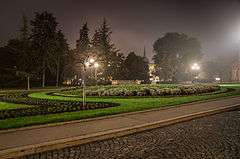Stari dvor
| Stari dvor Old Palace | |
|---|---|
| Стари двор | |
 The Old Palace – front view and main entrance | |
| General information | |
| Town or city | Belgrade |
| Country | Serbia |
| Construction started | 1882 |
| Completed | 1884 |
| Design and construction | |
| Architect |
Aleksandar Bugarski Jovan Ilkić |
Stari dvor (Serbian Cyrillic: Стари двор) meaning Old Palace, was the royal residence of the Obrenović dynasty. Today it houses the City Assembly of Belgrade. The palace is located on the corner of Kralja Milana and Dragoslava Jovanovića streets in Belgrade, Serbia, opposite Novi dvor (New Palace).
History

Stojan Simić, a politician and a businessman, member of the influential Simić family, notable in the 19th century Serbia both in politics and culture, purchased the lot in the late 1830s. It was a piece of marshland which encompassed the modern features of Old Palace, Pionirski Park and Park Aleksandrov. Simić drained the marsh, filled and leveled the terrain and on the northern side of the modern Kralja Milana street constructed a house 1840-42. The edifice became known as the Old Konak. Development of the first Serbian royal compound began in 1843-43, when the ruling prince Alexander Karađorđević purchased the konak with the surrounding garden.[1]
Instigated by King Milan,[1] the palace itself was built between 1882 and 1884, according to the design of Aleksandar Bugarski,[2] in the style of academism of the 19th century, with intention to surpass all existing residences of the Serbian rulers.
English author Herbert Vivien, who visited the palace by the end of the 19th century, described in detail its interior: "At the left side, there is a fine ball room, with walls of lemon-yellow colour, with huge white lusters of Venetian glass, glistening nicely during the state festivities, lit by electric light. After passing the large reception hall, you enter the banquet hall. Everything is glistening in that hall: starting from the floor up to the carved mahogany table. Some sixty guests may be seated around that table. Leather-upholstered chairs are of the colour of autumn leaves. What is most impressive, is the good taste characterizing all objects, both those for use and the adornments. The admiration is even more caused by the beautiful carved ceilings, inherited from the Turkish era and fashion."
A number of important events from the time of the political power of the Obrenović dynasty are linked to the Old Palace: the Palace was built when Serbia was proclaimed a Kingdom; in that same building, King Milan abdicated in favor of his son, Aleksandar, on 22 February 1889. Between 1903 and 1914, the Old Palace was the residence of the Karadjordjević dynasty. In 1919 and 1920, meetings of the Provisional National Assembly took place there. Royal festivities and receptions of foreign guests took place there until 1941.[3] It remained the royal residence until 1922 (King Peter, 1903-21) and King Alexander, 1921-22), until the neighboring Novi dvor became royal palace in 1922.[1]
World War I and II

The Palace was damaged twice: during World War I and during the bombing of Belgrade, on 6 April 1941. After World War I the Palace was repaired, while the first important restoration was done around 1930. The repair and re-arrangement of the Old Palace after World War II lasted until 1947. During that period, the architecture of the building was significantly changed. The two domes facing the garden were removed, while the facade facing the present Bulevar kralja Aleksandra was completely changed. Since that time, the building housed the Presidium of the National Assembly, then the federal government, and, since 1961, the City Assembly of Belgrade.
Architectural design

The Old Palace has almost square foundation of 40x40 m. Its design is classical, with central windowed inner hall. There used to be a greenhouse and richly ornamented oaken stairs added later, and leading onto the first floor (they were designed by a famous architect Jovan Ilkić). Those stairs were destroyed in World War I. Around this central space with columns and galleries there were other rooms of the Palace, the most important of them being the great hall for receptions and balls and the dining room. As parts of the Palace there were also a nicely arranged library and the Palace chapel, which faced the garden. The whole interior equipment of the Palace has been mostly imported from Vienna.

By its external architecture the building is one of the most beautiful achievements of academism in Serbia of the 19th century. The facade which faces the garden is most richly made, having projecting balconies which provided closer contact with the garden. The most characteristic motifs of this facade are the caryatids at the first-floor level which, above the balconies at each end of the facade support richly made tympanums of the ending windows. The caryatid are repeated on the facade facing the Kralja Milana street, and the line of Doric columns in beneath them. The Doric columns also appear on the facade against the garden, between richly decorated windows. The other two facades are somewhat simpler. The basement and the corners of the building are rustically designed. The balconies and the attic are balustraded. The three corners of the building used to have proportional domes.
Today

Today, the palace is home to the City Assembly of Belgrade. Visitors can take a tour inside the Old Palace. Tourists can sign up to visit the Old Palace at the tourist stands throughout Belgrade.
References
External links
| Wikimedia Commons has media related to Old Palace (Belgrade). |
- Stari dvor – City of Belgrade website (in Serbian)
Coordinates: 44°48′39″N 20°27′45″E / 44.81083°N 20.46250°E
